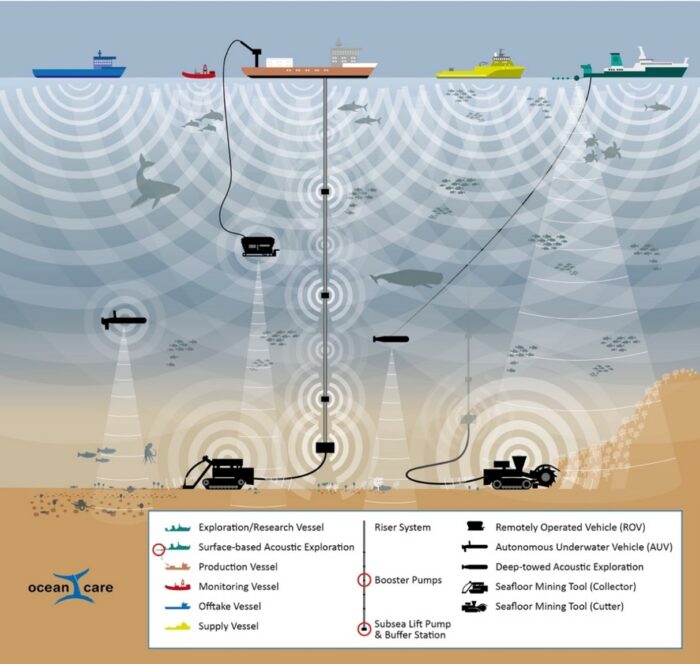Underwater noise is an important and harmful effect of deep-sea mining that has recently come into sharper focus. Ocean conservation organisation and Seas At Risk member, OceanCare specifically targets underwater noise pollution as a policy area, and recently published Deep-Sea Mining: A noisy affair. The report examines concerns about noise emissions from exploration and expected exploitation activities in the deep-sea and the threat they pose to marine life.
Underwater noise is emitted at all stages of deep-sea mining, through both temporary and near-constant sources, as shown in the diagram below. If deep-sea mining is permitted without further research and regulation, it will mean high levels of noise emitted constantly over decades.

Noise travels very quickly and efficiently underwater, at almost five times the speed of sound in air. Under certain conditions, low frequencies can be heard across thousands of ocean kilometres. At about 800-1,000 metres depth in temperate areas, the Sound Fixing and Ranging (SOFAR) Channel allows sound to travel almost unimpaired – similar to light conducted through a fibre optic cable.
So just how noisy is deep-sea mining? While the different densities of air and water make it difficult to compare noise levels and their potential impact, some rough comparisons are useful. Converted to decibels in air, many sources from deep-sea mining (e.g. sonar, vessels, dredging, drilling) emit noise levels estimated to be several hundred times louder than those of a space-rocket launch. These estimates show the noise from deep-sea mining to be a serious threat.
Around 150 marine species are known to be impacted by noise, and there is widespread agreement that underwater noise is a significant harmful pollutant. It is irresponsible to add another source of constant loud noise without further research on impacts or without significant efforts to reduce that noise.
Commercial shipping, oil and gas exploration, naval activities and construction have all contributed to increased noise levels in the ocean, with levels of human-generated noise doubling every decade since the 1960s in some regions. Deep-sea mining would take noise pollution to a whole new level, with loud noise sources throughout the entire deep water column for very long periods of time.
We know less about the deep ocean than the surface of the moon. To degrade this fragile ecosystem before we understand its full worth could haunt us for decades.
What next?
Several steps are crucial to protect marine species and ecosystems from harmful impacts of underwater noise from deep-sea mining:
1) Follow the precautionary principle in regulating and restricting noise emissions from deep-sea mining until there is a sound scientific foundation that the harm to marine species is not significant.
2) Create a solid scientific foundation covering all relevant aspects and potentially harmful effects of noise pollution through deep-sea mining.
3) Adopt relevant policy measures. The draft Mining Code should be paused, as should environmental protection regulations and guidance issued by the International Seabed Authority (ISA), until reliable data are available on the impact of noise emissions from deep-sea mining. The regulations should stipulate that underwater noise in and around mined areas should be at levels that are proven not to adversely affect the marine environment.
Posted on: 10 December 2021



